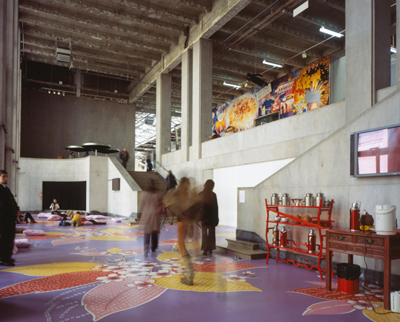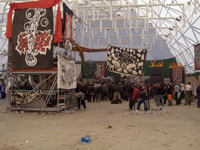You are in: Home page > Magazine Archive > Strategies in times of crisis

Anna Rita Amato
Strategies in times of crisis
Uses and reuses
Dock 7, slipway 3 of the ancient Puerto Madero in Buenos Aires, overlooking the banks of the River Plate has for years been a disused depot. Its recovery and reuse, which began in 1995, gave a new meaning to the more generic reorganisation of the river port promenade, creating a new image for the Argentine capital. The intervention brought new life to all the buildings of the ancient port, rethinking them as “functional metropolitan containers” able to house in a single wrapping, spaces for artisans, dwellings, and commercial and professional activities. The presupposition of the project began from respect for the pre-existing architectural layout, a historic place in an important sector of Buenos Aires, with the aim of bringing back dignity to an urban area that had lost its functions and vitality, thus bringing new economic development which has made it into one of the richest and most important tourist sites in the city.
There has been another attempt in the last few years to apply the self-same strategy to another important city: at the Paraná River port at Rosario, where an industrial building has been redesigned as a container for mixed functions that will allow the entire area to reacquire functions to meet the needs of a contemporary city. The interventions include the notable reuse of enormous silos that now house the fine art museum, a symbol of the Latin American city’s intense cultural activity.
In the interventions cited, the common denominator is the redevelopment of buildings, the legacy of an industrial phase by now past, which have lost their raison d’être. In both examples, the alternative would have been demolition, which would have incurred substantially greater costs as well as the problem of getting rid of the remains ― something unsustainable, above all from an environmental point of view.
The economic study of the interventions was certainly a decisive aspect in working out the strategies for the intervention, in a country like Argentina which is going through a significant economic crisis that has been fluctuating, with more or less dramatic peaks, for over two decades.
In the Western world too, the economic crisis of the last few years has brought to light the theme of “recycling” architecture. Already, some years ago In Italy there were debates on these problems: in October 2003, an issue of "L’Industria delle Costruzioni" came out, edited by Alessandra de Cesaris, which delved deeper into these themes, nowadays the centre of an exhibition in one of Italy’s most prestigious venues (the MAXXI in Rome, designed by Zaha Hadid). Unquestionably, in this historic moment, the world of architecture is much more sensitive to those themes that appear as a possible turning point to emerge from the paralyzing stasis of the economy, which only leaves room for the big names backed by enormous investments, which prefer packaging to the architectural product. The huge legacy of property abandoned by industry but not only, is reacquiring interest in as much as it may embody the response to the decay of many urban areas, above all in the suburbs, which now feature an almost total lack of architectural and landscape quality. However, this answer contemplates the sole possibility of the reuse and streamlining of such spaces, thereby excluding any phenomenon of demolition that would cause, in addition to a greater economic commitment, also major ecological problems linked to the waste disposal. On the other hand, the persistence of huge quantities of cubic metres left in a total state of abandonment should not be considered a sustainable answer either from the point of view of land use, nowadays such a precious asset, or because of the decay that such disused buildings bring to the urban areas where they belong.
In reality, the practice of reusing abandoned industrial buildings contains, in its very premise, a cultural phenomenon that we might define “spontaneous”: towards the end of the 1980s and for the whole of the ’90s, until our own times, the relicts of industry have been the place for the artistic/cultural expression of a global anarchic youth movement identified through the production of techno music. So-called TAZ (Temporarily Autonomous Zones) find, within the “architectural refuse” of contemporary society, appropriate space to express the cultural movement that revolves around the phenomenon of techno music. Industrial buildings as a natural habitat of new forms of art, over time, have then found a recognized “structure” and launched a series of interventions which until today have gained their own definition and morphological identity. The Giovanni and Marella Agnelli Art Gallery uses the spaces of the former Turin car factory known as Lingotto. In the Palais de Tokyo, a building created for the 1937 Paris World Fair and abandoned in 1974, Lacaton and Vassal remodelled and readapted its dark and inadequate spaces for the requirements of an important cultural centre, and in 1985 it was to become a great laboratory given over to photographic techniques. And lastly the case of the High Line, a New York railway infrastructure, and now an urban park that hosts cultural events as well as workshops of various kinds.
These events, above all linked to the reuse of abandoned architectural organisms are easily linked to phenomena which we might define smaller scale: reuse, or perhaps better, recycling, is a practice that has seen the birth of happy artistic expressions. From Duchamp, who upturned a urinal to create a fountain, to Fernando and Humberto Campana who currently create design objects from everyday tools, a new sensibility has been inspired as to the problem of refuse which, from a material destined for rubbish dumps becomes the basis for the development of a new environmental culture that seeks to repair the damage from unrestrained consumerism. The same concept has been expanded to embrace the larger scale of architectural objects by reusing the same principles of economy and sustainability. It is important to note however that in architecture the reuse of the built legacy is a phenomenon we have inherited from the past: when pagan temples were reused as new sacred Christian sites, when the structure of the Teatro di Marcello in Rome became Palazzo Corsini, or simply when Ancient Roman domestic interiors became spaces for private life in the Middle Ages, no one spoke of strategic avant-garde of the urban space but simply of normal economization of the built environment. The built environment is, and always has been, the “raw material” of architecture, whether residential through which all cities with along history have been stratified and built, one on top of the other, or grand special buildings which, behind the appearance of novelty, of magnificence, of the great work, always conceal an “economical” attention to the context, to the extant, to the already built, which moves hand in glove with the complexity and architectural richness of the “new”.
Anna Rita Amato, architect, PhD in the Department of Architecture and Project at the Sapienza University in Rome.















